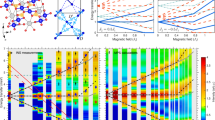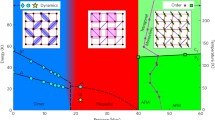Abstract
In a quantum phase transition, the ground state and low-temperature properties of a system change drastically as some parameter controlling zero-point quantum fluctuations is tuned to a critical value. Like classical phase transitions driven by thermal fluctuations, a ground-state transition can be discontinuous (first order) or continuous. Theoretical studies have suggested exotic continuous transitions where a system develops higher symmetries than those of the underlying Hamiltonian. Here, we demonstrate an unconventional discontinuous transition between two ordered ground states of a quantum magnet, with an emergent symmetry of its coexistence state. We present a Monte Carlo study of a two-dimensional S = 1/2 spin system hosting an antiferromagnetic state and a plaquette-singlet solid state of the kind recently detected in SrCu2(BO3)2. We show that the O(3) symmetric antiferromagnetic order and the scalar plaquette-singlet solid order form an O(4) vector at the transition. Unlike conventional first-order transitions, there are no energy barriers between the two coexisting phases, as the O(4) order parameter can be rotated at constant energy. Away from the transition, the O(4) surface is uniaxially deformed by the control parameter (a coupling ratio). This phenomenon may be observable in SrCu2(BO3)2.





Similar content being viewed by others
Data availability
The data that support the plots within this paper and other findings of this study are available from the corresponding author upon reasonable request.
References
Sachdev, S. Quantum magnetism and criticality. Nat. Phys. 4, 173–185 (2008).
Kaul, R. K., Melko, R. G. & Sandvik, A. W. Bridging lattice-scale physics and continuum field theory with quantum Monte Carlo simulations. Annu. Rev. Condens. Matter Phys. 4, 179–215 (2013).
Senthil, T., Vishwanath, A., Balents, L., Sachdev, S. & Fisher, M. P. A. Deconfined quantum critical points. Science 303, 1490–1494 (2004).
Senthil, T., Balents, L., Sachdev, S., Vishwanath, A. & Fisher, M. P. A. Quantum criticality beyond the Landau–Ginzburg–Wilson paradigm. Phys. Rev. B 70, 144407 (2004).
Sandvik, A. W. Evidence for deconfined quantum criticality in a two-dimensional Heisenberg model with four-spin interactions. Phys. Rev. Lett. 98, 227202 (2007).
Melko, R. G. & Kaul, R. K. Scaling in the fan of an unconventional quantum critical point. Phys. Rev. Lett. 100, 017203 (2008).
Jiang, F.-J., Nyfeler, M., Chandrasekharan, S. & Wiese, U.-J. From an antiferromagnet to a valence bond solid: evidence for a first-order phase transition. J. Stat. Mech. 2008, P02009 (2008).
Kuklov, A. B., Matsumoto, M., Prokof’ev, N. V., Svistunov, B. V. & Troyer, M. Deconfined criticality: generic first-order transition in the SU(2) symmetry case. Phys. Rev. Lett. 101, 050405 (2008).
Lou, J., Sandvik, A. W. & Kawashima, N. Antiferromagnetic to valence-bond-solid transitions in two-dimensional SU(N) Heisenberg models with multispin interactions. Phys. Rev. B 80, 180414(R) (2009).
Sandvik, A. W. Continuous quantum phase transition between an antiferromagnet and a valence-bond solid in two dimensions: evidence for logarithmic corrections to scaling. Phys. Rev. Lett. 104, 177201 (2010).
Chen, K. et al. Deconfined criticality flow in the Heisenberg model with ring-exchange interactions. Phys. Rev. Lett. 110, 185701 (2013).
Harada, K. et al. Possibility of deconfined criticality in SU(N) Heisenberg models at small N. Phys. Rev. B 88, 220408(R) (2013).
Block, M. S., Melko, R. G. & Kaul, R. K. Fate of CPN−1 fixed points with q monopoles. Phys. Rev. Lett. 111, 137202 (2013).
Pujari, S., Damle, K. & Alet, F. Néel-state to valence-bond-solid transition on the honeycomb lattice: evidence for deconfined criticality. Phys. Rev. Lett. 111, 087203 (2013).
Nahum, A., Chalker, J. T., Serna, P., Ortuño, M. & Somoza, A. M. Deconfined quantum criticality, scaling violations, and classical loop models. Phys. Rev. X 5, 041048 (2015).
Shao, H., Guo, W. & Sandvik, A. W. Quantum criticality with two length scales. Science 352, 213–216 (2016).
Zayed, M. et al. 4-Spin plaquette singlet state in the Shastry–Sutherland compound SrCu2(BO3)2. Nat. Phys. 13, 962–966 (2017).
Shastry, B. S. & Sutherland, B. Exact ground state of a quantum mechanical antiferromagnet. Physica B + C 108, 1069–1070 (1981).
Corboz, P. & Mila, F. Tensor network study of the Shastry–Sutherland model in zero magnetic field. Phys. Rev. B 87, 115144 (2013).
Nahum, A., Serna, P., Chalker, J. T., Ortuño, M. & Somoza, A. M. Emergent SO(5) symmetry at the Néel to valence-bond-solid transition. Phys. Rev. Lett. 115, 267203 (2015).
Karch, A. & Tong, D. Particle-vortex duality from 3D bosonization. Phys. Rev. X 6, 031043 (2016).
Metlitski, M. A. & Vishwanath, A. Particle-vortex duality of two-dimensional Dirac fermion from electric-magnetic duality of three-dimensional topological insulators. Phys. Rev. B 93, 245151 (2016).
Mross, D. F., Alicea, J. & Motrunich, O. I. Explicit derivation of duality between a free Dirac cone and quantum electrodynamics in (2 + 1) dimensions. Phys. Rev. Lett. 117, 016802 (2016).
Kachru, S., Mulligan, M., Torroba, G. & Wang, H. Non-supersymmetric dualities from mirror symmetry. Phys. Rev. Lett. 118, 011602 (2017).
Wang, C., Nahum, A., Metlitski, M. A., Xu, C. & Senthil, T. Deconfined quantum critical points: symmetries and dualities. Phys. Rev. X 7, 031051 (2017).
Qin, Y. Q. et al. Duality between the deconfined quantum-critical point and the bosonic topological transition. Phys. Rev. X 7, 031052 (2017).
Sato, T., Hohenadler, M. & Assaad, F. F. Dirac fermions with competing orders: non-Landau transition with emergent symmetry. Phys. Rev. Lett. 119, 197203 (2017).
Metlitski, M. A. & Thorngren, R. Intrinsic and emergent anomalies at deconfined critical points. Phys. Rev. B 98, 085140 (2018).
Gazit, S., Assaad, F. F., Sachdev, S., Vishwanath, A. & Wang, C. Confinement transition of Z2 gauge theories coupled to massless fermions: emergent QCD3 and SO(5) symmetry. Proc. Natl Acad. Sci. USA 115, E6987 (2018).
Sreejith, G. J., Powell, S. & Nahum, A. Emergent SO(5) symmetry at the columnar ordering transition in the classical cubic dimer model. Phys. Rev. Lett. 122, 080601 (2019).
Irkhin, V. Yu & Katanin, A. A. Thermodynamics of isotropic and anisotropic layered magnets: renormalization-group approach and 1/N expansion. Phys. Rev. B 57, 379–391 (1998).
Cuccoli, A., Roscilde, T., Tognetti, V., Vaia, R. & Verrucchi, P. Quantum Monte Carlo study of S = ½ weakly anisotropic antiferromagnets on the square lattice. Phys. Rev. B 67, 104414 (2003).
Sandvik, A. W. & Evertz, H. G. Loop updates for variational and projector quantum Monte Carlo simulations in the valence-bond basis. Phys. Rev. B 82, 024407 (2010).
Sandvik, A. W. Computational studies of quantum spin systems. AIP Conf. Proc. 1297, 135–338 (2010).
Sandvik, A. W. Finite-size scaling and boundary effects in two-dimensional valence-bond solids. Phys. Rev. B 85, 134407 (2012).
Senthil, T. & Fisher, M. P. A. Competing orders, nonlinear sigma models, and topological terms in quantum magnets. Phys. Rev. B 74, 064405 (2006).
Luck, J. M. Corrections to finite-size-scaling laws and convergence of transfer-matrix methods. Phys. Rev. B 31, 3069–3083 (1985).
Vollmayr, K., Reger, J. D., Scheucher, M. & Binder, K. Finite size effects at thermally-driven first order phase transitions: a phenomenological theory of the order parameter distribution. Z. Phys. B 91, 113–125 (1993).
Iino, S., Morita, S., Sandvik, A. W. & Kawashima, N. Detecting signals of weakly first-order phase transitions in two-dimensional Potts models. J. Phys. Soc. Jpn 88, 034006 (2019).
Sen, A. & Sandvik, A. W. Example of a first-order Néel to valence-bond-solid transition in two dimensions. Phys. Rev. B 82, 174428 (2010).
Kuklov, A., Prokof’ev, N. & Svistunov, B. Weak first-order superfluid–solid quantum phase transitions. Phys. Rev. Lett. 93, 230402 (2004).
Pelissettp, A. & Vicari, E. Multicritical behavior of two-dimensional anisotropic antiferromagnets in a magnetic field. Phys. Rev. B 76, 024436 (2007).
Hasenbusch, M. & Vicari, E. Anisotropic perturbations in three-dimensional O(N)-symmetric vector models. Phys. Rev. B 84, 125136 (2011).
Eichorn, A., Mesterházy, D. & Scherer, M. M. Multicritical behavior in models with two competing order parameters. Phys. Rev. E 88, 042141 (2013).
Hébert, F. et al. Quantum phase transitions in the two-dimensional hardcore boson model. Phys. Rev. B 65, 014513 (2001).
Demler, E., Hanke, W. & Zhang, S.-C. SO(5) theory of antiferromagnetism and superconductivity. Rev. Mod. Phys. 76, 909–974 (2004).
Wildeboer, J., D’Emidio, J. & Kaul, R. K. Emergent symmetry at a transition between intertwined orders in a S = 1 magnet. Preprint at https://arxiv.org/abs/1808.04731 (2018).
Serna, P. & Nahum, A. Emergence and spontaneous breaking of approximate O(4) symmetry at a weakly first-order deconfined phase transition. Preprint at https://arxiv.org/abs/1805.03759 (2018).
Muller, M. E. A note on a method for generating points uniformly on n-dimensional spheres. Commun. ACM 2, 19–20 (1959).
Beach, K. S. D. & Sandvik, A. W. Some formal results for the valence bond basis. Nucl. Phys. B 750, 142–178 (2006).
Liang, S., Doucot, B. & Anderson, P. W. Some new variational resonating-valence-bond-type wave functions for the spin-½ antiferromagnetic Heisenberg model on a square lattice. Phys. Rev. Lett. 61, 365–368 (1988).
Wolff, U. Collective Monte Carlo updating for spin systems. Phys. Rev. Lett. 62, 361–364 (1989).
Acknowledgements
The authors thank F. Assaad, R. Kaul, N. Kawashima, S. Li, Z.Y. Meng, A. Nahum, Y. Ran, S. Sachdev, H. Shao, L. Sun, J. Takahashi and Z.-C. Yang for stimulating discussions. This work was supported by the NSF under grant no. DMR-1710170 and by a Simons Investigator Award. The calculations were carried out on Boston University’s Shared Computing Cluster.
Author information
Authors and Affiliations
Contributions
A.W.S. conceived the CBJQ model and planned the study. The numerical simulations of the CBJQ model were implemented and carried out by B.Z. P.W. simulated the classical Heisenberg model. B.Z. analysed all data under the supervision of A.W.S. and with input from P.W. B.Z. wrote the initial draft of the manuscript, which was finalized by A.W.S. with input from B.Z. and P.W.
Corresponding author
Ethics declarations
Competing interests
The authors declare no competing interests.
Additional information
Publisher’s note: Springer Nature remains neutral with regard to jurisdictional claims in published maps and institutional affiliations.
Supplementary information
Supplementary Information
Supplementary text and Supplementary Figures 1–8.
Rights and permissions
About this article
Cite this article
Zhao, B., Weinberg, P. & Sandvik, A.W. Symmetry-enhanced discontinuous phase transition in a two-dimensional quantum magnet. Nat. Phys. 15, 678–682 (2019). https://doi.org/10.1038/s41567-019-0484-x
Received:
Accepted:
Published:
Issue Date:
DOI: https://doi.org/10.1038/s41567-019-0484-x
- Springer Nature Limited
This article is cited by
-
Field-controlled multicritical behavior and emergent universality in fully frustrated quantum magnets
npj Quantum Materials (2024)
-
Magnetoelectric phase transition driven by interfacial-engineered Dzyaloshinskii-Moriya interaction
Nature Communications (2021)
-
Ground state and stability of the fractional plateau phase in metallic Shastry–Sutherland system TmB4
Scientific Reports (2021)
-
Different Bell Inequalities as Probes to Detect Quantum Phase Transitions
International Journal of Theoretical Physics (2021)





